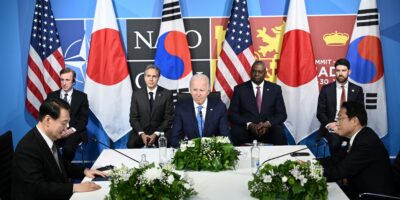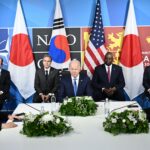
(Source – Shutterstock)
A chip supply of their very Won: South Korea wants to localize 50% of chips materials
- South Korea aims to locally source half of materials, components and equipment in the semiconductor manufacturing industry by 2030, up from the current 30%.
- Currently, it is estimated that about 20% of equipment and 50% of raw materials come from local suppliers.
- Under the plan, South Korea intends to spend KRW 950 billion on feasibility studies on the development of electric and automated chips between 2024 and 2030.
- A staggering KRW 1.25 trillion will be allocated. to develop artificial intelligence chips.
South Korea has been the world’s leading supplier of memory chips, but the pandemic has made it realize that just memory dominance isn’t enough. So the country started aiming for something bigger–to make itself the world’s largest chipmaking base over the next decade. The goal was followed by a string of chip-making plans that included an allocation of US$450 billion for the next ten years.
Considering how countries around the world have been embarking on reorganizing supply chains in ways that prioritize their own needs, South Korea recently took a similar stance. The country last week announced that it aims to locally source half of materials, components and equipment in the semiconductor manufacturing industry by 2030, up from the current 30%.
Currently, it is estimated that about 20% of equipment and 50% of raw materials come from local suppliers. “Despite some achievements in self-reliance, high-tech, key technologies are still heavily dependent on external parties,” the country’s chip industry ministry said in a joint statement with other ministries.
Adding to that, the ministry anticipates the supply chain to further destabilize since the US-China trade conflict and the Russia-Ukraine war is still ongoing. SK Hynix along with Samsung Electronics, two of South Korea’s coveted chip-making champions, have been looking to enhance supply chain stability and resources to become a superpower in this area.
As per Reuters report, the government and private sector plans to invest around 300 billion won (US$230 million) in small-business innovation and in mergers and acquisitions of chip design firms. The investment, according to the ministry, would begin next year. Under the plan, South Korea will also spend 950 billion won on feasibility studies on development of power and auto chips from 2024 to 2030 and 1.25 trillion won to develop artificial intelligence chips by 2029.
Additionally, the government will also consider funding for essential infrastructure, such as electricity and water supply, at places that serve as expanding chip production hubs, including Pyeongtaek and Yongin. It will also consider enlarging tax breaks for infrastructure investment by large firms. As for talents, the private sector and government would apparently work together to train at least 150,000 people over the next 10 years to bolster the semiconductor labor force, the ministry added.
When it comes to the semiconductor industry as a whole, the Biden administration has been focusing its efforts on convincing certain Asia Pacific ‘allies’ to forge an alliance known as the Chip 4. It would include the US itself, South Korea, Japan, and Taiwan. It is an apparent attempt by the US to counter China’s growing influence in global supply chains. For context, the allies were picked based on their respective strengths, whereby the US is a leading player in developing the most advanced chips, while Japan takes the lead in supplying key materials and equipment. South Korea and Taiwan on the other hand, boast manufacturing prowess.
However, the response has been slow from South Korea in particular despite the harder push from the US, as the former fears encountering significant pushback from its long time trading partner, China. While the alliance generally aims to reimagine supply chains of chips from production to distribution among friendly nations, China sees it as a counterproductive measure, causing market fragmentation.
READ MORE
- Ethical AI: The renewed importance of safeguarding data and customer privacy in Generative AI applications
- How Japan balances AI-driven opportunities with cybersecurity needs
- Deploying SASE: Benchmarking your approach
- Insurance everywhere all at once: the digital transformation of the APAC insurance industry
- Google parent Alphabet eyes HubSpot: A potential acquisition shaping the future of CRM


